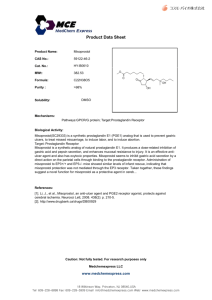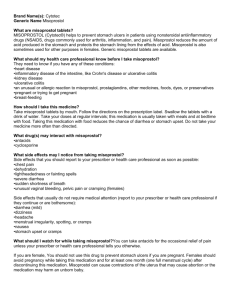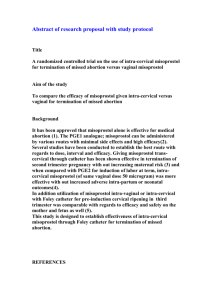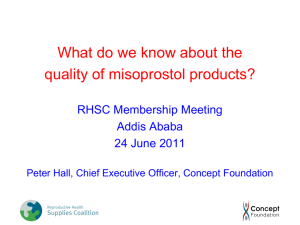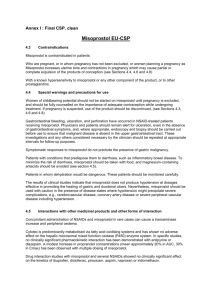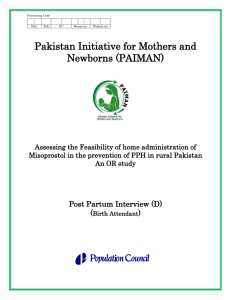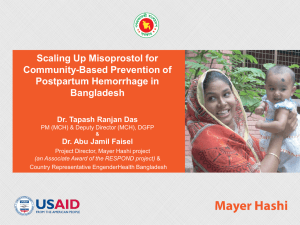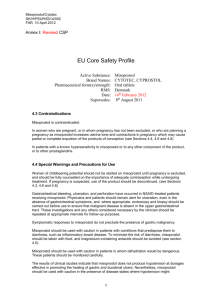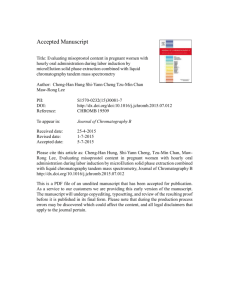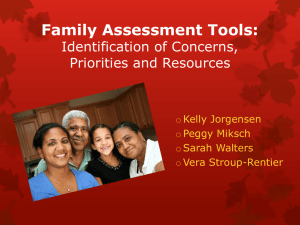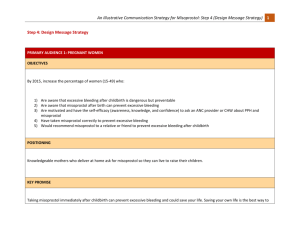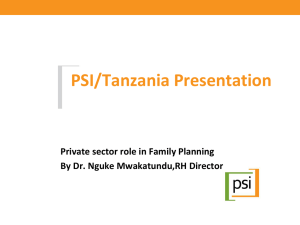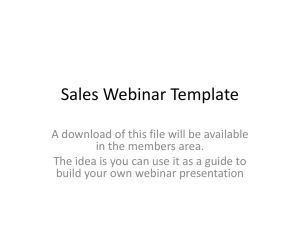Writing SMART Goals and Objectives
advertisement
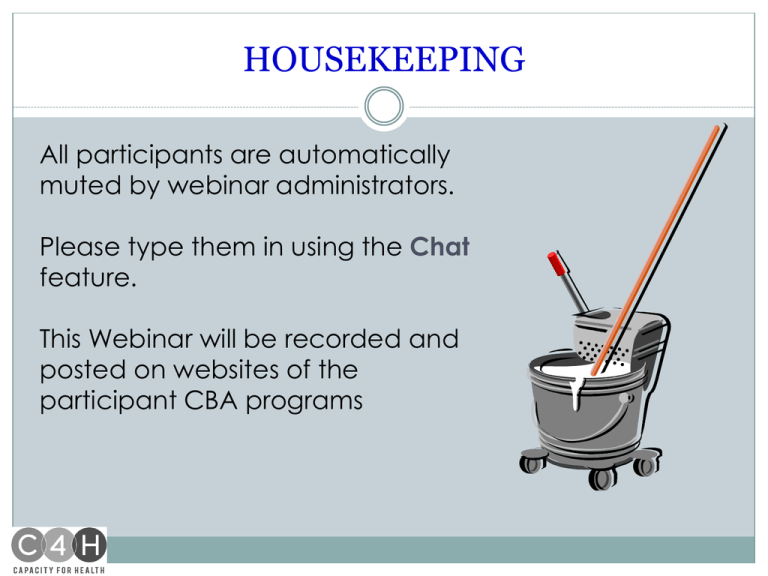
HOUSEKEEPING All participants are automatically muted by webinar administrators. Please type them in using the Chat feature. This Webinar will be recorded and posted on websites of the participant CBA programs THIS WEBINAR IS PART OF THE GRANT WRITING PREPAREDNESS SERIES CO-HOSTED BY: SHARED ACTION, AIDS PROJECT LOS ANGELES CAPACITY FOR HEALTH, ASIAN AND PACIFIC ISLANDER AMERICAN HEALTH FORUM CA STD/HIV PREVENTION TRAINING CENTER TODAY’S WEBINAR: WAS DEVELOPED BY: Capacity for Health at APIAHF, a Capacity Building Assistance Program, with offices in San Francisco and Washington D.C. WHO WE ARE: We are funded by The Centers for Disease Control and Prevention (CDC) to provide FREE trainings and one-on-one technical assistance for community-based organizations (CBOs) on: (1) Organizational Infrastructure and Program Sustainability, (2) Evidence-Based Interventions (EBIs) and Public Health Strategies, and (3) Monitoring and Evaluation. Webinar: Developing Logic Models THIS WEBINAR WILL BE RECORDED AND M A D E AVA I L A B L E T H R O U G H O U R W E B S I T E S ALONG WITH COPIES OF THE SLIDES DEVELOPING LOGIC MODELS LeConté Dill, DrPH (c), MPH Experience: Evaluation Consultant at the American Red Cross, AIDS Service Center, and Berkeley Youth Alternatives Centers for Disease Control & Prevention City of Berkeley Public Health Division UC Berkeley Center for Cities & Schools Education: UC Berkeley School of Public Health UCLA School of Public Health Spelman College Teaching: Program Planning & Evaluation Pedagogy Sociology of the Family TOPICS OF THIS WEBINAR Introductions Conversations and Questions Examples of Logic Models What a Logic Model is…and is not The Simple Form of a Logic Model LEARNING OBJECTIVES By the end of this Webinar, participants will: Have expanded their conceptualization of Logic Models Have a toolkit of various types of Logic Models Be able to use Logic Models as a tool for program planning Have at least one practical goal for improving the current elements of their program(s) WHAT A LOGIC MODEL IS … AND IS NOT FIRST QUARTER ON LOGIC… The relationship between elements, and the relationship between an element and the whole SOME HISTORY Logic Models: Were originally created by evaluators in the 1970s Became more popular with the W.K. Kellogg Foundation’s and CDC’s use in the 1990s WHAT IS A LOGIC MODEL? A systematic and visual way to share and present your understanding of the relationships among the resources you have to operate your program, the activities you plan, and the changes or results you hope to achieve. $ ∆ WHAT A LOGIC MODEL IS NOT 1. It is not reality. Is a simple model that represents program intention. 2. It is not complete. It does not display many cultural, social, and environmental factors that influence process and outcomes outside the program 3. Does not prove causal attribution of the intervention to the change 4. It is not a Theory of Change. But it relies on a social or behavioral theory or other theory of change. 5. Doesn’t address: Are we doing the right thing? A THEORY OF CHANGE…PROVIDES RATIONALE It provides rationale for the arrows in a logic model. Program provides cooking classes to teens Learn and practice menu planning & cooking skills Gain knowledge of healthy foods and shopping tips Receive nutritious free food for family Teens eat better Improved nutritional health Teens cook for family weekly It is the scientific or other basis for the “logic” in the logic model. Example from Dr. Lyn Paleo WHY USE A LOGIC MODEL? The road most traveled by… WHY USE A LOGIC MODEL? Makes Program Theory Explicit – “Connects the dots” between resources, activities and outcomes Assists with planning – See where we are, and where we want to be – Identify gaps in goals or activities Clarifies What to Evaluate Helps with communication and consensus-building LOGIC MODEL: SIMPLE FORM SECOND QUARTER EVERYDAY LOGIC MODEL H E A D A C H E Get pills Take pills Headache gone; Return to work Example from Dr. James Glasnapp LOGIC MODELS IN PROGRAM PLANNING W.K. Kellogg Foundation LOGIC MODEL: SIMPLE FORM Source: Kellogg Foundation, Logic Model Development Guide, www.wkkf.org Certain resources are needed to operate the program If you have access to them, then you can use them to accomplish your planned activities Resources / inputs Activities If you accomplish your planned activities, then you hopefully deliver the amount of product or service that you intended Outputs If you accomplish your planned activities to the extent you intended, then your participants will benefit in certain ways If these benefits to participants are achieved, then certain changes in organizations, communities, or systems might be expected to occur Outcomes Impact COMMON ELEMENTS IN LOGIC MODELS Resources / Inputs – What we invest Activities / Outputs – – Activities: What we do Participation: Who we reach “Chain of Outcomes” – – – Short-Term (1 to 3 years) Medium – Term (4 to 6 years) Long – Term (Impact: 7 – 10 years) Connectors – Arrows are really “If-Then Statements” LOGIC MODELS: SIMPLE FORM Resources / Inputs Activities Outputs Outcomes Impact INPUTS FACULTY STAFF MONEY TIME VOLUNTEERS PARTNERS EQUIPMENT OUTPUTS What we do Who we reach ACTIVITIES PARTICIPATION Workshops Counseling Facilitation Product development Curriculum design Trainings Field days Conferences Participants Clients Customers Users OUTCOMES What results for individuals, organizations, communities..… SHORT MEDIUM LONG-TERM Learning Action Conditions Awareness Knowledge Attitudes Skills Opinion Aspirations Motivation Behavior Practice Decisions Policies Social action Human Economic Civic Environment OUTCOMES FOR DIFFERENT TYPES OF PROGRAMS PROGRAMS WITH FACE-TO-FACE CONTACT SHORT MEDIUM LONG-TERM Changes in: [Head, heart, and gut] Changes in: [Actions] Changes in: [Well-being] • • • • • • • •Behavior •Skills • • • • Awareness Knowledge Attitudes Opinion Aspirations Motivation Behavioral intent • • Health Education Financial stability Relationships (including with offspring) Legal condition Addiction condition SOCIAL MARKETING PROGRAMS SHORT MEDIUM LONG-TERM Changes in: Changes in: Changes in: Awareness of campaign Attitudes Behaviors Group norms Understanding of message Aspirations Opinion Motivation Behavioral intent Health Education Financial stability Relationships (including with offspring) Legal condition Addiction condition POLICY AND ADVOCACY PROGRAMS SHORT Media contacts MEDIUM Media reps come to our org for back story Messages and materials developed Media coverage of issues Coalition developed Coalition builds capacity and skills LONG-TERM Regulations or Laws passed and enforced http://www.planning.continuousprogress.org/ TIPS ON CREATING A LOGIC MODEL 1. A logic model should be easy to read and understand by stakeholders who are only somewhat familiar with your program. 2. Make it clear who does what and who receives what. Subject – verb – object 3. Achieve a balance between showing enough detail and not too much detail. LOGIC MODELS: EXAMPLES THIRD QUARTER HIV PREVENTION EXAMPLES www.effectiveinterventions.org/Files/MP_LogicModel.pdf HIV PREVENTION EXAMPLES www.effectiveinterventions.org/Files/SISTA_Logic_Model.pdf HIV PREVENTION EXAMPLES http://www.effectiveinterventions.org/Files/FOY_Logic_Model.pdf HIV PREVENTION EXAMPLES www.effectiveinterventions.org/Files/10-0204_Safety_Counts_Logic_Model_(view).pdf ADDITIONAL EXAMPLES ADDITIONAL EXAMPLES W.K. Kellogg Foundation ADDITONAL EXAMPLES The VERB™ Campaign Logic Model: A Tool for Planning and Evaluation Marian Huhman, PhD, Carrie Heitzler, MPH, and Faye Wong, MPH, RD Preventing Chronic Disease v.1(3); Jul 004 http://www.ncbi.nlm.nih.gov/pmc/articles/PMC1253476/ ADDITIONAL EXAMPLES www.cchers.org ADDITIONAL EXAMPLES http://eobhc.net/docs/ FLESHING OUT THE SIMPLE FORM Resources Activities Outputs Outcomes Impact In order to accomplish out set of activities, we will need the following: In order to address our problem or asset, we will conduct the following: Once completed or underway, these activities will produce the following evidence of service delivery: If completed or ongoing, these activities will lead to the following changes in the next 1-3 years, then 4-6 years: If completed, these activities will lead to the following changes in the 7-10 years: CHECKING YOUR LOGIC Are the outcomes really outcomes? Is the longest-term outcome meaningful? Is it logical? Is it realistic? Does it represent the program’s purpose; response to the situation? LINKS TO GOALS AND OBJECTIVES Input/Resources Activities Output Process Objectives Effects/Outcomes Impact Outcome Objectives Goals “Funding, expertise and supplies provided by this project to train community health workers to establish and maintain a misoprostol distribution system and to provide appropriate community health education will result in adequate and consistent supply of misoprostol and a community education network that will lead to increased acceptability of misoprostol and increased use of misoprostol by women. These changes will contribute to improving the health status of the women by reducing the morbidity and mortality related to postpartum hemorrhage.” Example from Dr. Julianna Deardorff “Funding, expertise and supplies provided by this project to train community health workers to establish and maintain a misoprostol distribution system and to provide appropriate community health education will result in adequate and consistent supply of misoprostol and a community education network that will lead to increased acceptability of misoprostol and increased use of misoprostol by women. These changes will contribute to improving the health status of the women by reducing the morbidity and mortality related to postpartum hemorrhage.” Dr. Julianna Deardorff “Funding, expertise and supplies provided by this project to train community health workers to establish and maintain a misoprostol distribution system and to provide appropriate community health education will result in adequate and consistent supply of misoprostol and a community education network that will lead to increased acceptability of misoprostol and increased use of misoprostol by women. These changes will contribute to improving the health status of the women by reducing the morbidity and mortality related to postpartum hemorrhage.” Dr. Julianna Deardorff “Funding, expertise and supplies provided by this project to train community health workers to establish and maintain a misoprostol distribution system and to provide appropriate community health education will result in adequate and consistent supply of misoprostol and a community education network that will lead to increased acceptability of misoprostol and increased use of misoprostol by women. These changes will contribute to improving the health status of the women by reducing the morbidity and mortality related to postpartum hemorrhage.” Dr. Julianna Deardorff “Funding, expertise and supplies provided by this project to train community health workers to establish and maintain a misoprostol distribution system and to provide appropriate community health education will result in adequate and consistent supply of misoprostol and a community education network that will lead to increased acceptability of misoprostol and increased use of misoprostol by women. These changes will contribute to improving the health status of the women by reducing the morbidity and mortality related to postpartum hemorrhage.” Dr. Julianna Deardorff “Funding, expertise and supplies provided by this project to train community health workers to establish and maintain a misoprostol distribution system and to provide appropriate community health education will result in adequate and consistent supply of misoprostol and a community education network that will lead to increased acceptability of misoprostol and increased use of misoprostol by women. These changes will contribute to improving the health status of the women by reducing the morbidity and mortality related to postpartum hemorrhage.” Dr. Julianna Deardorff Additional Resources W.K. Kellogg Foundation’s Evaluation Handbook: www.wkkf.org/knowledge-center/resources/2010/W-KKellogg-Foundation-Evaluation-Handbook.aspx Diffusion of Effective Behavioral Interventions (DEBI) Project: www.effectiveinterventions.org CDC’s Framework for Program Evaluation in Public Health: http://www.cdc.gov/mmwr/pdf/rr/rr4811.pdf Additional Resources Slides and a recorded version of this webinar will be available on the following websites: AIDS Project Los Angeles- Shared Action www.sharedaction.org Capacity 4 Health, APIAHF www.capacity4health.org CA STD/HIV Prevention Training Center www.stdhivtraining.org Contact us for individualized capacity building assistance CONVERSATION AND QUESTIONS FOURTH QUARTER Thank You!
